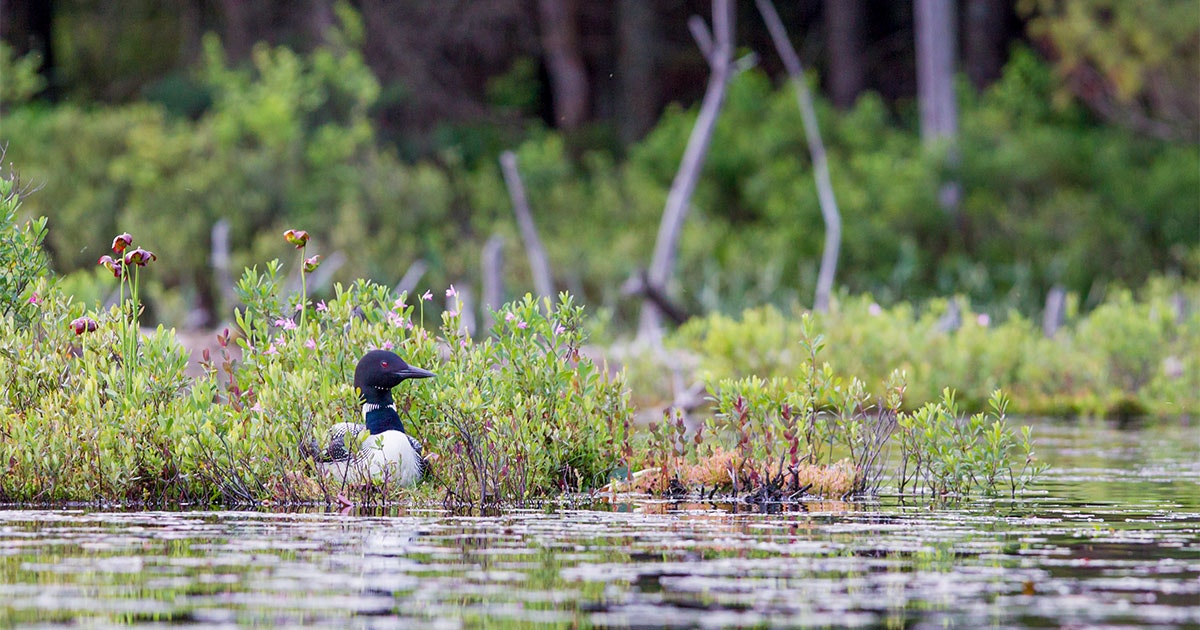Across the Northeast last summer, the rain seemed unrelenting. In July, the Adirondacks experienced catastrophic flash flooding that breached dams, destroyed roads, and raised one Adirondack lake’s water level by around three feet. New Hampshire issued more flash flood advisories in July alone than in any full year on record. It was the wettest summer on the books in the state along with Maine and Vermont, while Massachusetts and New York flirted with record territory.
The rain came at a critical time for Common Loons, which establish nests in late spring and spend around a month incubating their eggs. Excellent swimmers but clumsy on land, loons build their nests at the water’s edge, where they are vulnerable to flooding.
As a result, “loon productivity was not great last year all around the Northeast,” says Lucas Savoy, director of the loon program at the Biodiversity Research Institute in Portland, Maine. The Loon Preservation Committee in New Hampshire found eggs that had been picked up and carried by floods more than a quarter-mile from their nests. A record 42 Common Loon nests flooded in that state, where the birds had their third-worst recorded year for hatching success. In Maine, an unusual number of loons forwent nesting altogether, says Tracy Hart, a conservation biologist with Maine Audubon. Hart saw flooded nests and observed some birds incubating moldy eggs—“just clearly inviable,” she says—that never hatched.
As another summer approaches with potential for flooding, Common Loon researchers and conservationists are watching anxiously and hoping the birds will catch a break. It’s natural for loons to have some poor nesting years, and not every pair produces chicks every year, says Carrie Gray, a boreal conservation specialist with the National Audubon Society. “If one year they’re not producing chicks because it got flooded, there’s nothing to be too alarmed about,” she says. But if researchers see reduced productivity year after year, Gray says, “that’s another matter.”
Unfortunately for Common Loons and those working to preserve the species, the too-wet summer of 2023 was not an isolated incident. An Adirondack Center for Loon Conservation 2023 climate report found that the percentage of nests failing due to high water in the Adirondacks steadily increased between 2001 and 2018, and the amount of rainfall during nesting season was the primary factor affecting reproductive success. In Massachusetts, Common Loon reproduction was unsustainably low in 15 out of 22 years leading up to a 2020 report. Data from New Hampshire show that as total precipitation increases in June and July, the number of chicks hatched per nesting pair declines. Parts of Canada have also seen nest flooding and declining reproduction.
Loons face other threats across their range, including lead poisoning, parasites, and mercury exposure. Climate change brings a host of additional challenges. Extreme heat causes loons to leave their nests to cool down, exposing eggs to high temperatures and predators. Heavy precipitation increases populations of mosquitoes that can spread avian malaria and black flies that harass loons so badly they sometimes abandon their nests. Rainfall also spreads contaminants and reduces water clarity, making it difficult for loons to find food for their young. “Reproduction seems to be going down, mortality seems to be going up,” says Mark Pokras, a wildlife veterinarian at Tufts University who has studied loons for around 40 years. “That’s not a good combination.”
In an effort to turn things around, loon conservationists are making increasing use of nest rafts that rise and fall with fluctuating water levels, which research shows can improve nesting success. The Loon Preservation Committee deployed 151 rafts last year, up from their five-year average of 104 rafts. Maine Audubon deployed 57 rafts, up from 27 the year before.
Still, the rafts are not a cure-all, and can do more harm than good if they’re not strategically placed, researchers say: They can increase competition among adult loons and attract avian predators. The Biodiversity Research Institute has used the artificial platforms as part of its work to reintroduce loons to areas the birds used to frequent, but Savoy notes the group is strategic about it. “We don’t want to just deploy a lot of these platforms if we feel like they’re not needed,” he says. “If loons can adapt, that’s better.”
The challenges facing the species are substantial, but Common Loons are resilient. They have been documented, for example, feverishly building up the walls of their nests during rainstorms to protect eggs from rising waters. Because the birds don’t start breeding until they are around six years old, it will take a while for population numbers to reflect recent declines in reproductive success, Pokras says. But in the meantime, conserving healthy shorelines where possible, and offering the birds nest rafts where needed, can help to give them a fighting chance.

